Broken Pelvis
What is a Fractured Pelvis?
A fractured pelvis is a break of the ring of bones that connect your spine to the hips. These fractures usually result from high energy injuries such as car accidents or falls from a height in younger patients and most often from falls in the elderly patient. The pelvis can be broken into many pieces or just crack slightly depending on the quality of bone and the type of injury. Pelvic fractures are described according to where and how the bone breaks and they are classified into different types by injury pattern. Differentiation of these injuries can be complex and these injuries can be treated by an orthopedic trauma specialist at the Reno Orthopedic Center in Reno, Sparks, or Carson City.
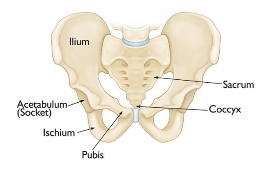
Illustration of pelvic bone. Reproduced with permission from OrthoInfo. © American Academy of Orthopaedic
Surgeons. https://orthoinfo.org/
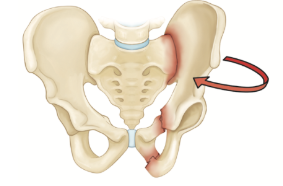
Illustration of pelvic bone. Reproduced with permission from OrthoInfo. © American Academy of Orthopaedic
Surgeons. https://orthoinfo.org/
What does the Pelvis do?
The pelvis is the structure responsible for connecting the spine to the lower body. With a broken pelvis you cannot walk, sit or move well without pain. The pelvis protects the bladder, intestines and many important blood vessels. Many of the important leg muscles and abdominal muscles attach to the pelvis and allow for body motion and function.
Fractures Pelvis Symptoms
Some symptoms of a broken or fractured pelvis can include…
- Pain in your groin, hip or lower back
- Swelling over the pelvic bone
- Pain when moving your legs
- Numbness or tingling in your groin or upper thighs
- Abdomen pain
- Difficulty urinating
- Difficulty and pain when walking or standing
How is a Broken Pelvis Diagnosed?
Pelvic fractures are often caused by high energy injuries. Most patients are brought to a trauma center because these injuries often have associated head, chest or abdominal trauma.
- Physical examinations are critical in the evaluation of these injuries. Important nerves and blood vessels run next to this bone and can be injured when it breaks. Diagnosis of an injury to some blood vessels requires urgent surgery. Several types of pelvis pelvic fractures cause life threatening injuries and without stabilization, patients can die.
- X-rays are used to evaluate the location and severity of the broken pelvic bone. This helps doctors and patients make an informed decision on treatment. Often 5 or more x-rays are taken to show the injury pattern.
- CT (Computed Tomography) scans are often ordered to help plan treatment and surgery. These can create a 3-D image of the injury broken pelvic bone which gives doctors specific knowledge about the size and location of the broken bones. In elderly patients with pelvis pain and normal x-rays or CT scans, an MRI is sometimes ordered to diagnose a fracture due to weak bone or osteoporosis known as an insufficiency fracture.
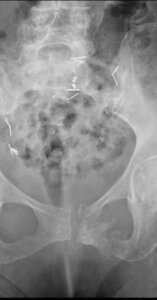
Broken Pelvic Bone X-Ray
Fractured Pelvis Treatment & Surgery
Treatment for pelvic fractures can be non-surgical or surgical depending on the stability of the broken bone and whether the fracture is displaced or not. Severe pelvic fractures usually require surgery.
Non-Surgical Treatment
Nonsurgical treatment is recommended for stable pelvic fractures that are non-displaced. These include isolated pubic ramus fractures, isolated sacral fractures, avulsion fractures and some iliac wing fractures. Insufficiency fractures in elderly patients are usually treated non-operatively as well.
If non-operative care is chosen, regular follow-up care for a physical exam and x-rays is important to ensure that the fracture stays in good position and heals appropriately. Cutting down or quitting smoking and tight blood sugar control if you are a diabetic is important for the healing process. One fall or continued lack of compliance with early walking against medical advice can cause bones to move and result in the need for surgery.
Some types of fractures allow for immediate weight bearing while others do not. Patients will require gait aids such as crutches or walkers. Depending on health and injury pattern this bone can take 3-4 months to heal without surgery. Physical therapy for hip and knee range of motion is started around 6 weeks once bone has healed enough to prevent displacement with motion. Most patients will be placed on a blood thinner to avoid clots for 2-6 weeks.
Surgical Treatment
An unstable broken pelvis requires surgery. Surgeons like to fix these pelvic fractures as soon as possible. However, due to the fact that many patients have other injuries, the surgery has to wait until patients are cleared for surgery by the general surgeons. Occasionally surgery has to be delayed several days if patients are too sick or unstable from a medical standpoint for surgery.
Because the hip socket can break in many different ways, there are several types of pelvic fracture surgery and surgical approaches that can be done to fix the injury. The surgeon will decide which is best for each injury pattern. In most cases, these are fixed with plates and screws. A combination of large and small incisions are used to fix these injuries. Surgery usually takes 1 to 3 hours. Most patients stay in the hospital for several days after surgery.
These are relatively rare injuries. It is important to choose your surgeon wisely. While in the hospital, it is your right as a patient to request the physician you think best to treat your injury. Extensive surgical experience can be helpful in achieving a good result and avoiding complications. Collectively, ROC surgeons have performed more broken pelvis surgeries than any practice in northern Nevada and take pride in outstanding surgical results. The ROC has 4 dedicated orthopedic trauma surgeons who work as a team to treat these difficult injuries.
After pelvic fracture surgery, patients are not allowed to bear weight or walk for six to 10 weeks. You will be taught by physical therapy to use crutches or a walker before leaving the hospital. Your doctor may decide to put you on a blood thinner after surgery for 2-6 weeks depending on your risk factors.
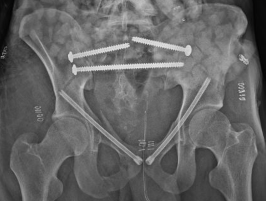
Postoperative x-ray of pelvic fracture repair.
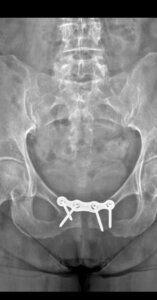
Post-Operative X-Ray of Pelvic Fracture Surgery
Pelvic Fracture Surgery Risks & Complications
Complications can occur with any surgery, no matter how small. Some of the most common risks associated with pelvic fracture surgery include:
- Infections are a much bigger risk for larger and more contaminated traumatic wounds. A dose of antibiotics given prior to surgery helps to make this risk as small as possible.
- Injury to blood vessels or nerves can occur after pelvic fracture surgery. This can be reduced by having an experienced surgeon in your care.
- Blood clots in the legs can be developed following surgery. If not treated, the blood clots can break off and go into the lungs. This can cause serious bleeding problems and even death. Noncompliance with blood thinning medication can have fatal consequences. It is always possible that the bone may not heal and additional surgery will be required. This is usually associated with patient noncompliance, diabetes, or use of nicotine like smoking and chewing tobacco.
- Sexual dysfunction is a complication of pelvic fracture surgery due to the nature of these injuries. 30 percent of patients experience some form of sexual dysfunction such as erectile problems in males and dyspareunia (painful sex) in females. It is important to mention these symptoms to your surgeon so appropriate referral and treatments can occur.
Recovery After Pelvic Fracture Surgery
Most people with a broken pelvis take about 4-6 months to heal. If anatomic alignment was achieved at surgery and no complications occur, patients are able to return to prior activities and function. By six weeks, patients are fairly comfortable. They cannot be released to full activities such as manual labor, skiing and motocross until about four months. Aggressive return to activity too early can result in re-fracture, hardware breakage or nonunion. In these cases revision surgery is required. Patients can develop pain from the hardware placed in surgery. Some of these screws can be removed 6-12 months after surgery.
In need of an orthopedic specialist? Schedule an appointment with one of our specialty-trained Trauma and Fracture doctors to talk through your options. Reno Orthopedic Clinic offers comprehensive treatment for a full range of traumatic injuries at multiple convenient locations in Reno, Sparks and Carson City.
